Abstract
Hydroxyurea inhibits the activity of ribonucleotide reductase (ribonucleoside-diphosphate reductase; 2'-deoxy-ribonucleoside-diphosphate:oxidized-thioredoxin 2'-oxidoreductase, EC 1.17.4.1) in bacteria and mammalian cells. The reductase from Escherichia coli consists of two nonidentical subunits (B1 and B2) and hydroxyurea acts by specifically destroying a tyrosine free radical of B2 required for enzyme activity. The mammalian enzyme also consists of two nonidentical subunits (M1 and M2), only one of which (M1) has been obtained in pure form. By continuous culture at stepwise increasing drug concentrations, we have now obtained a 3T6 mouse fibroblast cell line with a 100-fold increased resistance to hydroxyurea. Extracts from resistant cells showed a 3- to 15-fold increase in reductase activity. The amount of M1 protein was not increased. The amount of M2 protein could not be measured directly, but the M2 activity in extracts from resistant cells (but not normal cells) showed an EPR spectrum very similar to that of the tyrosine radical of the bacterial B2 subunit. We propose that resistance to hydroxyurea is caused either by overproduction of the complete M2 subunit or by increased generation of the tyrosine radical within the M2 protein. It seems that either alternative mirrors a possible normal regulatory mechanism for the activity of the reductase.
Full text
PDF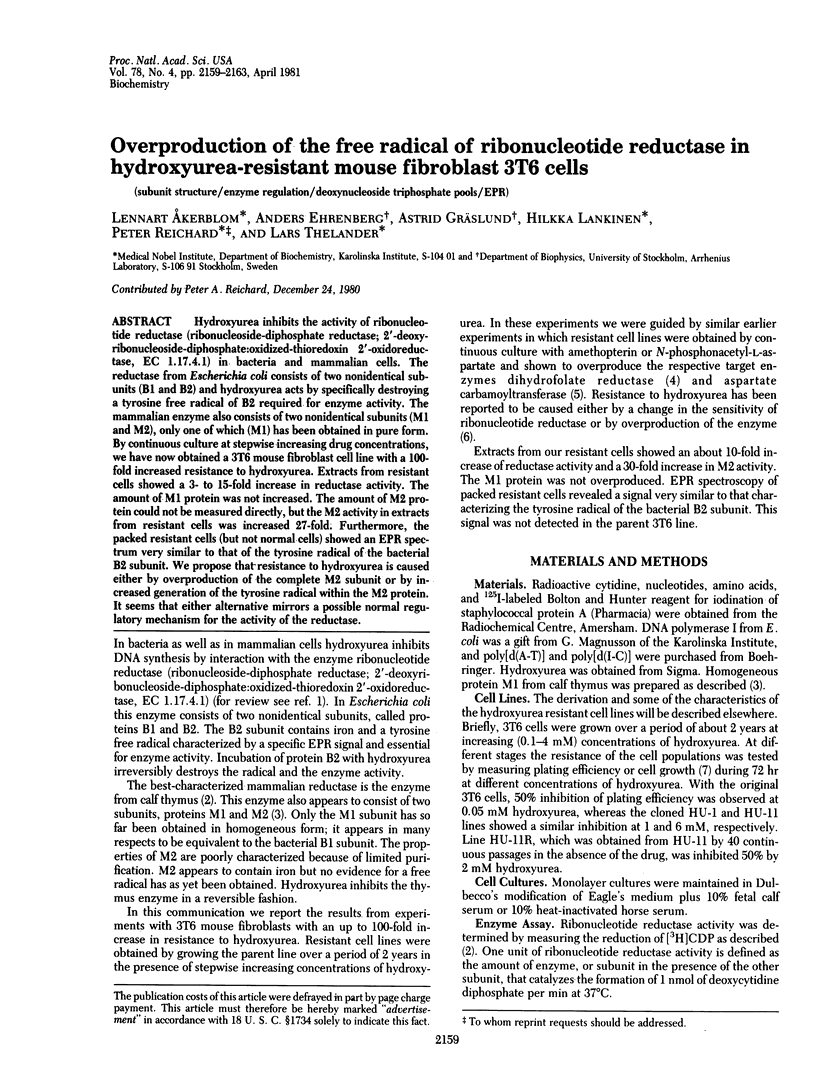
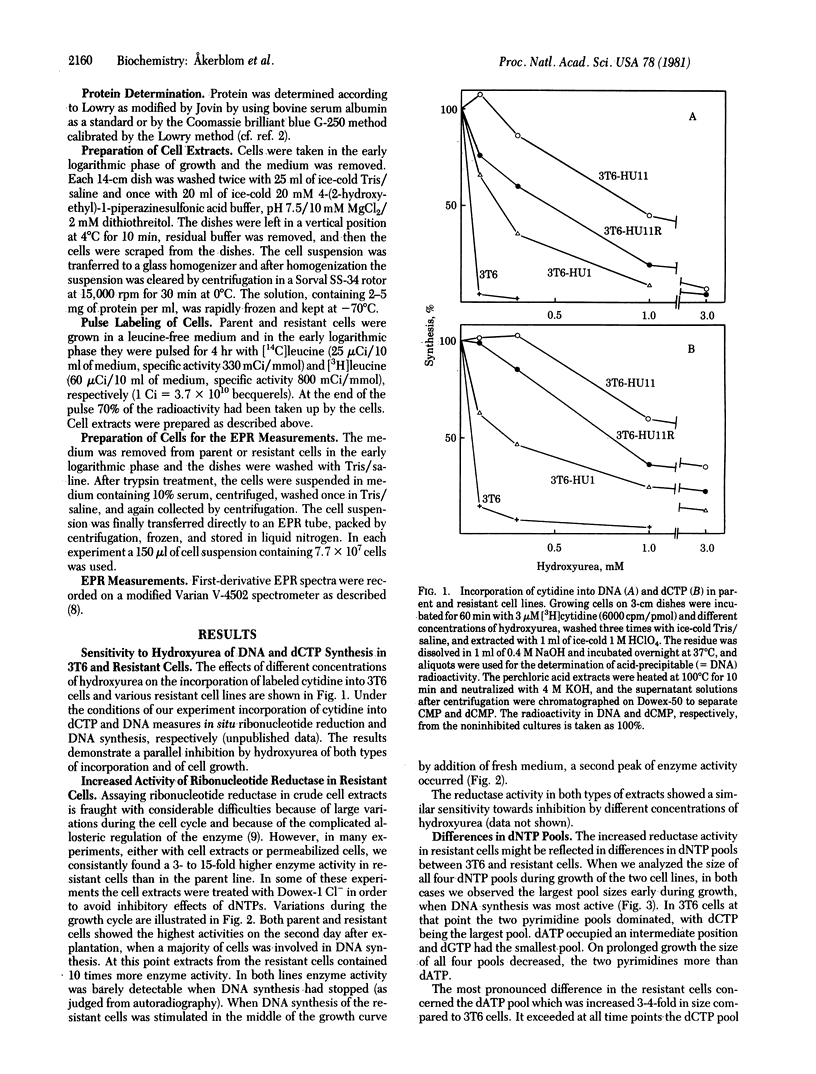
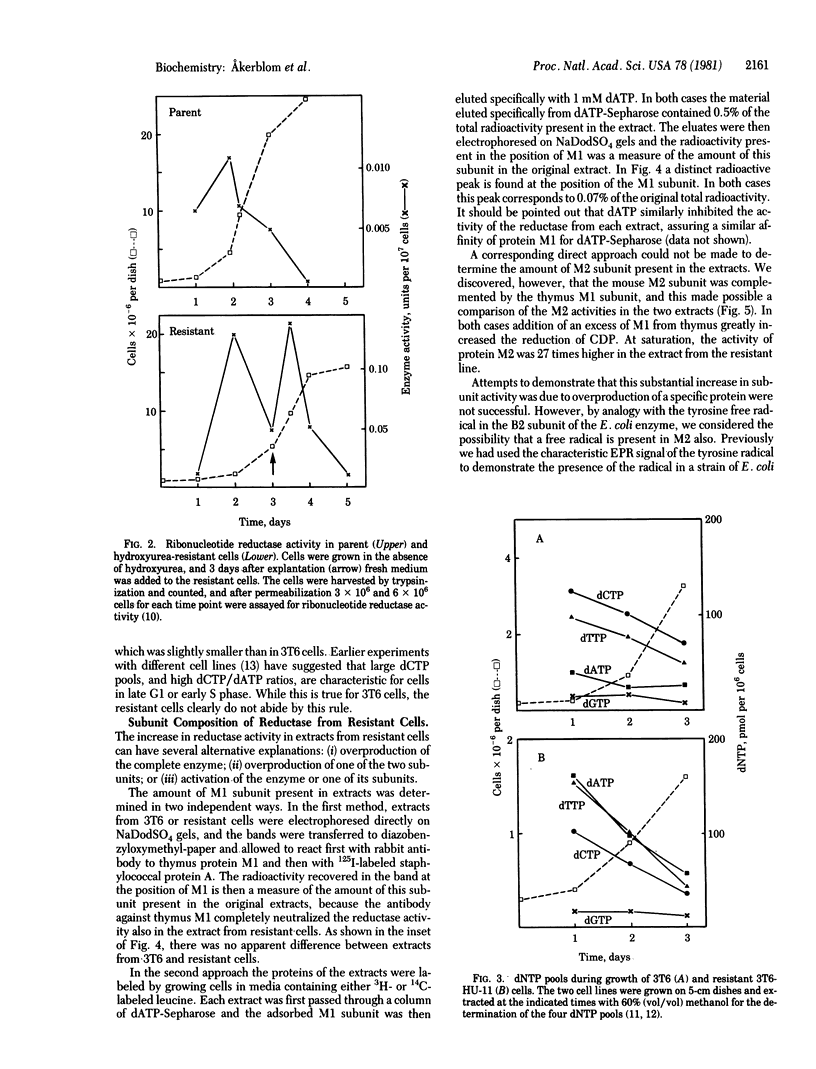
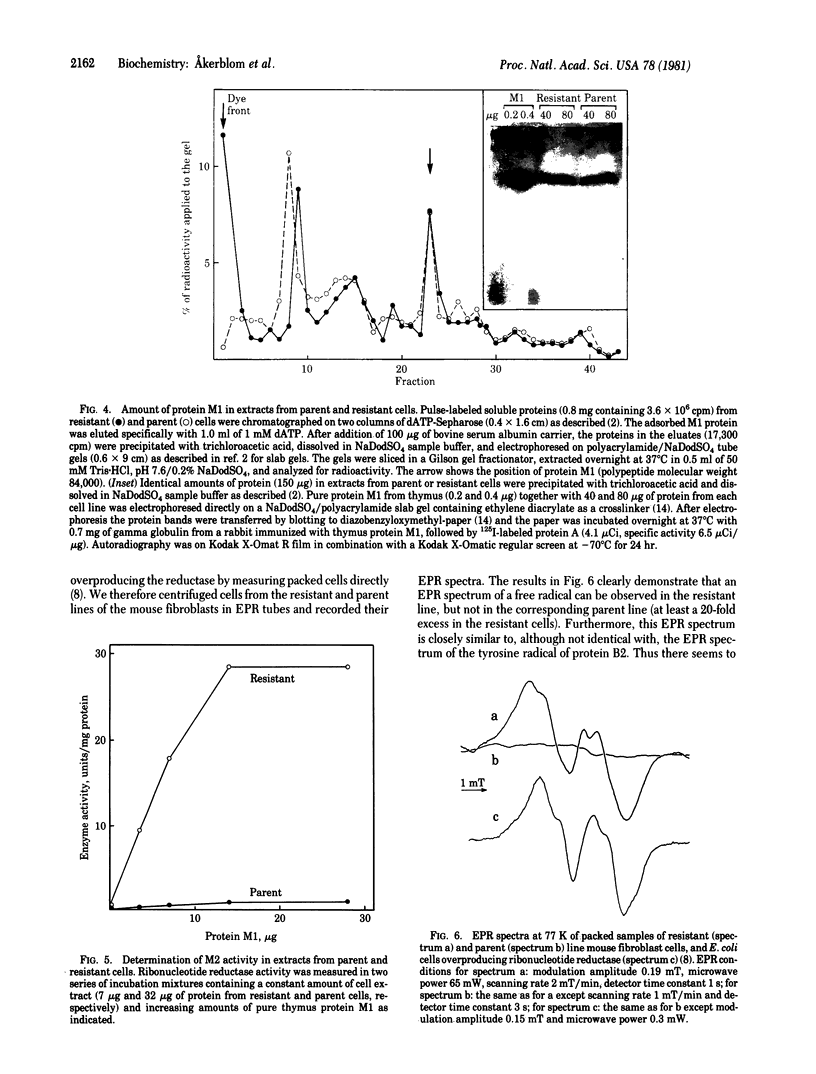
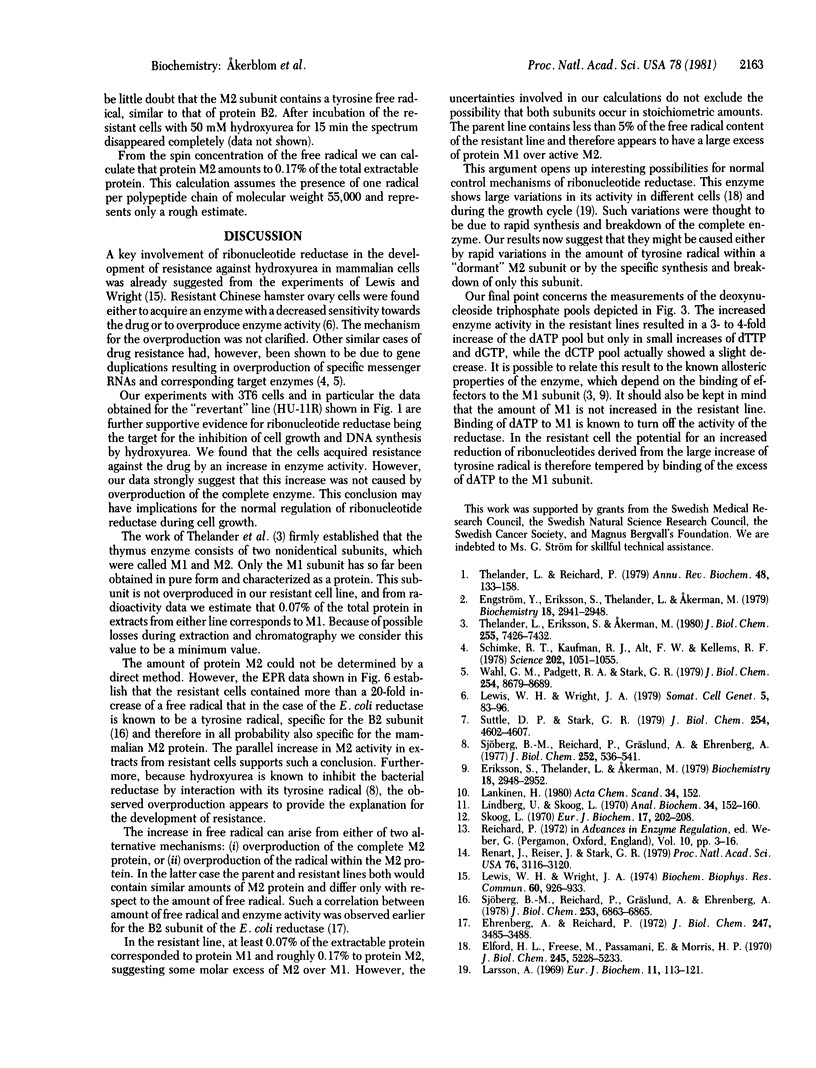
Images in this article
Selected References
These references are in PubMed. This may not be the complete list of references from this article.
- Ehrenberg A., Reichard P. Electron spin resonance of the iron-containing protein B2 from ribonucleotide reductase. J Biol Chem. 1972 Jun 10;247(11):3485–3488. [PubMed] [Google Scholar]
- Elford H. L., Freese M., Passamani E., Morris H. P. Ribonucleotide reductase and cell proliferation. I. Variations of ribonucleotide reductase activity with tumor growth rate in a series of rat hepatomas. J Biol Chem. 1970 Oct 25;245(20):5228–5233. [PubMed] [Google Scholar]
- Engström Y., Eriksson S., Thelander L., Akerman M. Ribonucleotide reductase from calf thymus. Purification and properties. Biochemistry. 1979 Jul 10;18(14):2941–2948. doi: 10.1021/bi00581a004. [DOI] [PubMed] [Google Scholar]
- Eriksson S., Thelander L., Akerman M. Allosteric regulation of calf thymus ribonucleoside diphosphate reductase. Biochemistry. 1979 Jul 10;18(14):2948–2952. doi: 10.1021/bi00581a005. [DOI] [PubMed] [Google Scholar]
- Lankinen H. Ribonucleotide reductase over-production in hydroxyurea resistant mouse cells. Acta Chem Scand B. 1980;34(2):152–152. [PubMed] [Google Scholar]
- Larsson A. Ribonucleotide reductase rom regenerating rat liver. Eur J Biochem. 1969 Nov;11(1):113–121. doi: 10.1111/j.1432-1033.1969.tb00747.x. [DOI] [PubMed] [Google Scholar]
- Lewis W. H., Wright J. A. Altered ribonucleotide reductase activity in mammalian tissue culture cells resistant to hydroxyurea. Biochem Biophys Res Commun. 1974 Oct 8;60(3):926–933. doi: 10.1016/0006-291x(74)90403-3. [DOI] [PubMed] [Google Scholar]
- Lewis W. H., Wright J. A. Isolation of hydroxyurea-resistant CHO cells with altered levels of ribonucleotide reductase. Somatic Cell Genet. 1979 Jan;5(1):83–96. doi: 10.1007/BF01538788. [DOI] [PubMed] [Google Scholar]
- Lindberg U., Skoog L. A method for the determination of dATP and dTTP in picomole amounts. Anal Biochem. 1970 Mar;34:152–160. doi: 10.1016/0003-2697(70)90096-5. [DOI] [PubMed] [Google Scholar]
- Reichard P. Control of deoxyribonucleotide synthesis in vitro and in vivo. Adv Enzyme Regul. 1972;10:3–16. doi: 10.1016/0065-2571(72)90003-9. [DOI] [PubMed] [Google Scholar]
- Renart J., Reiser J., Stark G. R. Transfer of proteins from gels to diazobenzyloxymethyl-paper and detection with antisera: a method for studying antibody specificity and antigen structure. Proc Natl Acad Sci U S A. 1979 Jul;76(7):3116–3120. doi: 10.1073/pnas.76.7.3116. [DOI] [PMC free article] [PubMed] [Google Scholar]
- Schimke R. T., Kaufman R. J., Alt F. W., Kellems R. F. Gene amplification and drug resistance in cultured murine cells. Science. 1978 Dec 8;202(4372):1051–1055. doi: 10.1126/science.715457. [DOI] [PubMed] [Google Scholar]
- Sjöberg B. M., Reichard P., Gräslund A., Ehrenberg A. The tyrosine free radical in ribonucleotide reductase from Escherichia coli. J Biol Chem. 1978 Oct 10;253(19):6863–6865. [PubMed] [Google Scholar]
- Skoog L. An enzymatic method for the determination of dCTP and dGTP in picomole amounts. Eur J Biochem. 1970 Dec;17(2):202–208. doi: 10.1111/j.1432-1033.1970.tb01154.x. [DOI] [PubMed] [Google Scholar]
- Suttle D. P., Stark G. R. Coordinate overproduction of orotate phosphoribosyltransferase and orotidine-5'-phosphate decarboxylase in hamster cells resistant to pyrazofurin and 6-azauridine. J Biol Chem. 1979 Jun 10;254(11):4602–4607. [PubMed] [Google Scholar]
- Thelander L., Eriksson S., Akerman M. Ribonucleotide reductase from calf thymus. Separation of the enzyme into two nonidentical subunits, proteins M1 and M2. J Biol Chem. 1980 Aug 10;255(15):7426–7432. [PubMed] [Google Scholar]
- Thelander L., Reichard P. Reduction of ribonucleotides. Annu Rev Biochem. 1979;48:133–158. doi: 10.1146/annurev.bi.48.070179.001025. [DOI] [PubMed] [Google Scholar]
- Wahl G. M., Padgett R. A., Stark G. R. Gene amplification causes overproduction of the first three enzymes of UMP synthesis in N-(phosphonacetyl)-L-aspartate-resistant hamster cells. J Biol Chem. 1979 Sep 10;254(17):8679–8689. [PubMed] [Google Scholar]



